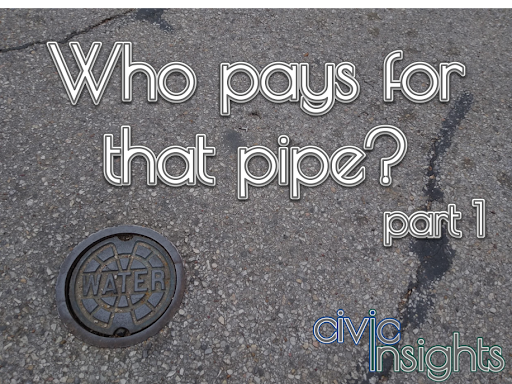Civic Insights: Who Pays for that Pipe? Part I
(City council, school board, planning commission, county commissioners – these groups and several others represent us. They do the day to day work of running our community. It is our responsibility to keep informed about their work so that we can help them represent us effectively. “Civic Insights” by Jeffrey Vitarius is a regular feature of Act Locally Waco. Its purpose is to help us understand decisions that shape our community so that we can participate effectively as informed, engaged residents of Waco. – ALW)

By Jeffrey Vitarius
What is a fair way to pay for the infrastructure improvements required for new developments? That is the question at the heart of a policy the city has been considering since January 2019: impact fees.
In 2016, the City adopted a comprehensive twenty-five year plan that noted that “the question is not whether Waco will grow, but what form will this growth take. It is important that Waco grow in a manner that is economically, environmentally, and culturally sustainable.” One of the critical challenges this plan identified was that of “increasingly dispersed development,” development occurring farther and farther away from the city’s core.
Why would this be a challenge? Let’s start with the basics. Imagine a set of new homes on a few acres of land that used to be a farm. This new development will need a few things to thrive, for example, roads to connect it to the rest of the city, and pipes to carry water in and wastewater (also known as sewage) out.
Even if there are already roads and pipes in the area, it may not just be a matter of connecting the new development to the existing network. Our new batch of homes will mean increased volume of cars, water, and wastewater in that part of the city. The roads and pipes around the development may need to be upgraded to handle the increased volume. We call these kinds of projects – to construct new roads and pipes or upgrade existing roads and pipes for more volume – “infrastructure improvements.” There are plenty of other kinds of infrastructure improvements, but for the purpose of discussing impact fees, we will focus on these.
It is one of the city’s jobs to construct these pipes and roads. The challenge comes in how to pay for these projects. The city already has a substantial inventory of roads and pipes that it needs to monitor, repair, and eventually replace.
How can the city pay for all of its current obligations much less the additional demands from new development? As the twenty-five year plan identifies “given the limited capacity and deteriorated condition of existing infrastructure, the City cannot afford to provide subsidies to encourage development at suburban densities in rural areas.” In plain English that means: our new set of suburban houses on what used to be farmland creates a financial difficulty for the city. Enter the impact fee.
The concept of the impact fee is fairly straightforward though it can get complicated in implementation and practice. The twenty-five year plan explains that impact fees serve as “a means of ensuring new development pays an equitable share of the costs associated with the construction and expansion of public infrastructure needed to service new development…Impact fees shift some of the cost of financing public facilities [roads and pipes] from the general taxpayer to the direct beneficiaries of these facilities [roads and pipes].”
In other words, impact fees move the cost of improvement from the city generally (where it is paid by existing taxpayers) to the developments that are more directly served by those improvements. If we think back to our former farm, theoretically impact fees would require that the developer pay part of the cost of the roads and pipes. The use of the phrase “equitable share” in the quote above hints at the large complicated question around this simple policy idea. At what amount is an impact fee fair?
Within that question are two considerations, the first is a matter of analysis and the second is a matter of policy. First the city has to determine how much impact fees could be to cover the cost of anticipated development. Then the much more difficult question of how much the impact fees should be can be addressed. In Waco we are in the transition from the could part of this process to the should part of this process.
In July of 2019, the city formed the Capital Improvement Advisory Committee to review the impact fee question (among other things) and make recommendations to the City Council on how to best proceed with this policy. That committee met this week to discuss the conclusion of the could part of the process (maximum fee calculations) and the start of the should part of that process (policy considerations).
Like many of the topics we take a look at in Civic Insights, this one is complicated and will take a few posts to get through. It looks like the City Council will be holding a public hearing on this question on October 6th. I will aim to get us caught up with the could part of the process by then.
Meeting notes:
- Waco Capital Improvements Advisory Committee met on 09/09/20 – For the full agenda click here

Jeffrey Vitarius has been actively local since early 2017. He lives in Sanger Heights with partner (JD) and his son (Callahan). He helped found Waco Pride Network and now serves as that organization’s treasurer and Pride Planning Chair. Jeffrey works at City Center Waco where he helps keep Downtown Waco clean, safe, and vibrant. He is a member of St. Alban’s Episcopal Church and graduated from Baylor in 2011.
The Act Locally Waco blog publishes posts with a connection to these aspirations for Waco. If you are interested in writing for the Act Locally Waco Blog, please email [email protected]for more information.
